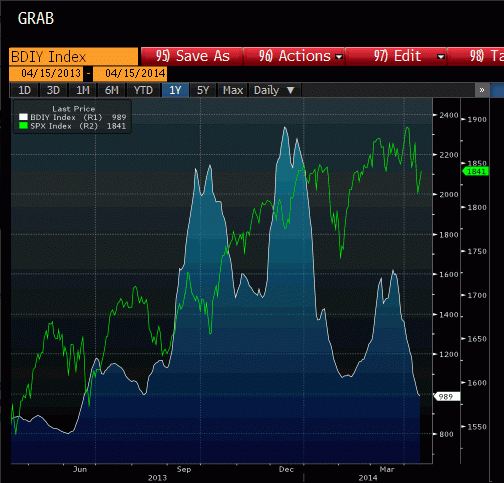There has been a lot of talk over the last month about whether or not we're heading into a market correction, or even the beginning of a bear market.
A trend that has supported the bearish side of these arguments has been weakness in the Baltic Dry Index over the last month, which fell once again Tuesday morning, dipping 1.9 percent below the key 1,000 level to 970.
Used to price shipping worldwide, the Baltic Dry Index is employed by logistics teams to calculate costs, but also by macro traders as a leading indicator of macro economic strength. Moves in the index tend to be demand-driven, with high demand for shipping sending the index, and thus shipping prices, upwards. To those who would use the index for macroeconomic forecasting, a drop from above 1,500 in late March to its current level at 970 could be worrisome.
With large oceangoing vessels moving “over 99 percent of U.S. overseas trade by weight and 65 percent by value,” according to the American Association of Port Authorities, a drop in the Baltic Dry Index, which implies a drop in traffic, provides more fundamental weakness to this market.
On a one-year chart, the Baltic Dry Index charts pretty well against the S&P 500 (ARCA:SPY) itself, loosely predicting a majority of market rallies and dips within a few days. The green line below is the S&P 500 while the blue area represents the 15-day simple moving average of the Baltic Dry Index.

Aside from the weakness in the Baltic Dry Index, a very poor New York Empire State Manufacturing Index report Tuesday morning, which came in at 1.29, far below the expected 8.0 and prior report of 5.61, could add to a bear case.
The weak final third quarter US GDP reading at the end of March certainly doesn't help the bulls, either.
While Tuesday's drop can't necessarily be attributed to a weak Baltic Dry Index reading, market weakness over the past two weeks comes as little surprise to those who have been watching the index's sharp decline since late March.
As the Street credits the Federal Reserve with a majority of 2013's market rally, the recent tapering, weakening market fundamentals and turbulence in Ukraine could be a potent enough combination for a market pullback.
